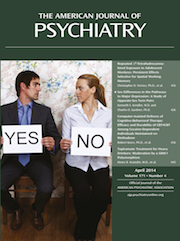Sex Differences in the Pathways to Major Depression: A Study of Opposite-Sex Twin Pairs
Abstract
Objective
The authors sought to clarify the nature of sex differences in the etiologic pathways to major depression.
Method
Retrospective and prospective assessments of 20 developmentally organized risk factors and the occurrence of past-year major depression were conducted at two waves of personal interviews at least 12 months apart in 1,057 opposite-sex dizygotic twin pairs from a population-based register. Analyses were conducted by structural modeling, examining within-pair differences.
Results
Sixty percent of all paths in the best-fit model exhibited sex differences. Eleven of the 20 risk factors differed across sexes in their impact on liability to major depression. Five had a greater impact in women: parental warmth, neuroticism, divorce, social support, and marital satisfaction. Six had a greater impact in men: childhood sexual abuse, conduct disorder, drug abuse, prior history of major depression, and distal and dependent proximal stressful life events. The life event categories responsible for the stronger effect in males were financial, occupational, and legal in nature.
Conclusions
In a co-twin control design, which matches sisters and brothers on genetic and familial-environmental background, personality and failures in interpersonal relationships played a stronger etiologic role in major depression for women than for men. Externalizing psychopathology, prior depression, and specific “instrumental” classes of acute stressors were more important in the etiologic pathway to major depression for men. The results are consistent with previously proposed typologies of major depression that suggest two subtypes that differ in prevalence in women (deficiencies in caring relationships and interpersonal loss) and men (failures to achieve expected goals, with lowered self-worth).



